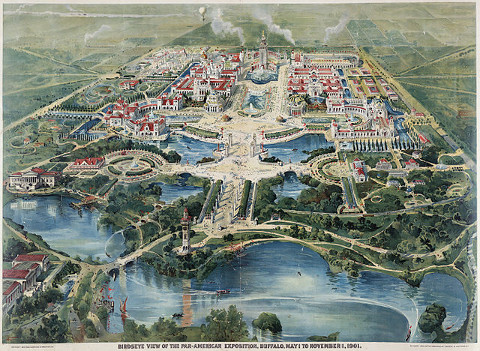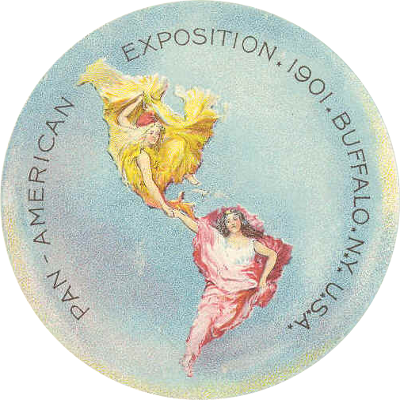The World's Pan-American Exposition 1901
 The Pan-American Exposition was a World's Fair held in Buffalo, New York, United States,
from May 1 through November 2, 1901. The fair occupied 350 acres (1.4 km2) of land on
the western edge of what is now Delaware Park, extending from Delaware Avenue to Elmwood
Avenue and northward to Great Arrow Avenue.
The Pan-American Exposition was a World's Fair held in Buffalo, New York, United States,
from May 1 through November 2, 1901. The fair occupied 350 acres (1.4 km2) of land on
the western edge of what is now Delaware Park, extending from Delaware Avenue to Elmwood
Avenue and northward to Great Arrow Avenue.
The event was organized by the Pan-American Exposition Company, formed in 1897. Cayuga
Island was initially chosen as the place to hold the Exposition because of the island's
proximity to Niagara Falls, which was a huge tourist attraction.  When the Spanish–American
War broke out in 1898, plans were put on hold. After the war, there was a heated competition
between Buffalo and Niagara Falls over the location. Buffalo won for two main reasons. First,
Buffalo had a much larger population—with roughly 350,000 people, it was the eighth-largest
city in the United States. Second, Buffalo had better railroad connections—the city was within
a day's journey by rail for over 40 million people. In July 1898, Congress pledged $500,000 for
the Exposition to be held at Buffalo. The "Pan American" theme was carried throughout the event
with the slogan
When the Spanish–American
War broke out in 1898, plans were put on hold. After the war, there was a heated competition
between Buffalo and Niagara Falls over the location. Buffalo won for two main reasons. First,
Buffalo had a much larger population—with roughly 350,000 people, it was the eighth-largest
city in the United States. Second, Buffalo had better railroad connections—the city was within
a day's journey by rail for over 40 million people. In July 1898, Congress pledged $500,000 for
the Exposition to be held at Buffalo. The "Pan American" theme was carried throughout the event
with the slogan
"commercial well being and good understanding among the American Republics."
The advent of the alternating current power transmission system in the US allowed designers to light the Exposition in Buffalo using power generated 25 miles (40 km) away at Niagara Falls.
Assassination of President McKinley
The exposition is most remembered because President William McKinley was shot by an anarchist, Leon Czolgosz, at the Temple of Music on September 6, 1901; the President died 8 days later. McKinley had given an address at the exposition the previous day; his speech included the following words:
"Expositions are the timekeepers of progress. They record the world's advancements. They stimulate the energy, enterprise, and intellect of the people, and quicken human genius. They go into the home. They broaden and brighten the daily life of the people. They open mighty storehouses of information to the student...."
The newly developed X-ray machine was displayed at the fair, but doctors were reluctant to use it on McKinley to search for the bullet because they did not know what side effects it might have had on him. Also, the operating room at the exposition's emergency hospital did not have any electric lighting, even though the exteriors of many of the buildings were covered with thousands of light bulbs. Doctors used a pan to reflect sunlight onto the operating table as they treated McKinley's wounds.
Click on the Medals tab to see some of the medals issued for this exposition.
Click or tap the medals to see their reverse sides.


The medal's obverse bears Liberty walking alongside a Buffalo. Around top, PAN-AMERICAN EXPOSITION; in exergue, field for dedication.
The medal's reverse bears South-American and North-American Native Americans smoking peace pipe together, shields with representations of their respective continents at their feet. Above, BVFFALO / VSA MCMI
The Pan-American Exposition was a World's Fair held in Buffalo, New York from May 1st through November 2nd, 1901. The exposition is most remembered for the shooting of U.S. President William McKinley. Anarchist Leon Czolgosz shot him on September 6th while he was visiting the fair.
The medal exists in plain bronze, silver and gilted bronze variants. The silver variants are very rare but no mintages have been reported.
The medal measures 64mm in diameter and was manufactured by the Gorham Silver Company.
References: Baxter 106, Marqusee 250
Contact me if you have links that might merit inclusion on this page.